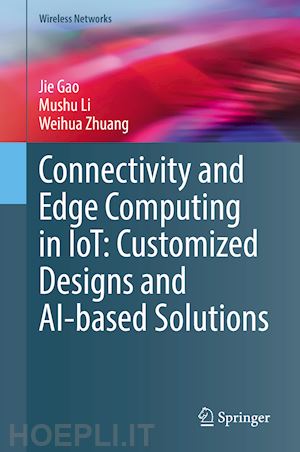
Questo prodotto usufruisce delle SPEDIZIONI GRATIS
selezionando l'opzione Corriere Veloce in fase di ordine.
Pagabile anche con Carta della cultura giovani e del merito, 18App Bonus Cultura e Carta del Docente
This book covers connectivity and edge computing solutions for representative Internet of Things (IoT) use cases, including industrial IoT, rural IoT, Internet of Vehicles (IoV), and mobile virtual reality (VR). Based on their unique characteristics and requirements, customized solutions are designed with targets such as supporting massive connections or seamless mobility and achieving low latency or high energy efficiency. Meanwhile, the book highlights the role of artificial intelligence (AI) in future IoT networks and showcases AI-based connectivity and edge computing solutions.
The solutions presented in this book serve the overall purpose of facilitating an increasingly connected and intelligent world. The potential benefits of the solutions include increased productivity in factories, improved connectivity in rural areas, enhanced safety for vehicles, and enriched entertainment experiences for mobile users. Featuring state-of-the-art research in the IoT field, this book can help answer the question of how to connect billions of diverse devices and enable seamless data collection and processing in future IoT. The content also provides insights regarding the significance of customizing use case-specific solutions as well as approaches of using various AI methods to empower IoT.
This book targets researchers and graduate students working in the areas of electrical engineering, computing engineering, and computer science as a secondary textbook or reference. Professionals in industry who work in the field of IoT will also find this book useful.
Introduction.- 1.1 The Era of Internet of Things.- 1.2 Connectivity in IoT.- 1.3 Edge Computing in IoT.- 1.4 AI in IoT.- 1.5 Scope and Organization of This Book.- References.- 2 Industrial Internet of Things: Smart Factory.- 2.1 Industrial IoT Networks.- 2.2 Connectivity Requirements of Smart Factory.- 2.2.1 Application-Specific Requirements.- 2.2.2 Related Standards.- 2.2.3 Potential Non-Link-Layer Solutions.- 2.2.4 Link-Layer Solutions: Recent Research Efforts.- 2.3 Protocol Design for Smart Factory.- 2.3.1 Networking Scenario.- 2.3.2 Mini-Slot based Carrier Sensing (MsCS).- 2.3.3 Synchronization Sensing (SyncCS).- 2.3.4 Di_erentiated Assignment Cycles.- 2.3.5 Superimposed Mini-slot Assignment (SMsA).- 2.3.6 Downlink Control.- 2.4 Performance Analysis.- 2.4.1 Delay Performance with No Buaer.- 2.4.2 Delay Performance with Buaer.- 2.4.3 Slot Idle Probability.- 2.4.4 Impact of SyncCS.- 2.4.5 Impact of SMsA.- 2.5 Scheduling and AI-Assisted Protocol Parameter Selection.- 2.5.1 Background.- 2.5.2 The Considered Scheduling Problem.- ix.- x Contents.- 2.5.3 Device Assignment.- 2.5.4 AI-Assisted Protocol Parameter Selection.- 2.6 Numerical Results.- 2.6.1 Mini-Slot Delay with MsCS, SyncCS, and SMsA.- 2.6.2 Performance of the Device Assignment Algorithms.- 2.6.3 DNN-Assisted Scheduling.- 2.7 Summary.- References.- 3 UAV-Assisted Edge Computing: Rural IoT Applications.- 3.1 Background on UAV-Assisted Edge Computing.- 3.2 Connectivity Requirements of UAV-assisted MEC for Rural.- IoT.- 3.2.1 Network Constraints.- 3.2.2 State-of-the-Art Solutions.- 3.3 Multi-Resource Allocation for UAV-Assisted Edge Computing.- 3.3.1 Network Model.- 3.3.2 Communication Model.- 3.3.3 Computing Model.- 3.3.4 Energy Consumption Model.- 3.3.5 Problem Formulation.- 3.3.6 Optimization Algorithm for UAV-Assisted Edge.- Computing.- 3.3.7 Proactive Trajectory Design based on Spatial.- Distribution Estimation.- 3.4 Numerical Results.- 3.5 Summary.- References.- 4 Collaborative Computing for Internet of Vehicles.- 4.1 Background on Internet of Vehicles.- 4.2 Connectivity Challenges for MEC.- 4.2.1 Server Selection for Computing Offoading.- 4.2.2 Service Migration.- 4.2.3 Cooperative Computing.- 4.3 Computing Task Partition and Scheduling for Edge Computing.- 4.3.1 Collaborative Edge Computing Framework.- 4.3.2 Service Delay.- 4.3.3 Service Failure Penalty.- 4.3.4 Problem Formulation.- 4.3.5 Task Partition and Scheduling.- 4.4 AI-Assisted Collaborative Computing Approach.- 4.5 Performance Evaluation.- 4.5.1 Task Partition and Scheduling Algorithm.- 4.5.2 AI-based Collaborative Computing Approach.- Contents xi.- 4.6 Summary.- References.- 5 Edge-assisted Mobile VR.- 5.1 Background on Mobile Virtual Reality.- 5.2 Caching and Computing Requirements of Mobile VR.- 5.2.1 Mobile VR Video Formats.- 5.2.2 Edge Caching for Mobile VR.- 5.2.3 Edge Computing for Mobile VR.- 5.3 Mobile VR Video Caching and Delivery Model.- 5.3.1 Network Model.- 5.3.2 Content Distribution Model.- 5.3.3 Content Popularity Model.- 5.3.4 Research Objective.- 5.4 Content Caching for Mobile VR.- 5.4.1 Adaptive Field-of-View Video Chunks.- 5.4.2 Content Placement on an Edge Cache.- 5.4.3 Placement Scheme for Video Chunks in a VS.- 5.4.4 Placement Scheme for Video Chunks of Multiple VSs.- 5.4.5 Numerical Results.- 5.5 AI-assisted Mobile VR Video Delivery.- 5.5.1 Content Distribution.- 5.5.2 Intelligent Content Distribution Framework.- 5.5.3 WI-based Delivery Scheduling.- 5.5.4 Reinforcement Learning Assisted Content Distribution.- 5.5.5 Neural Network Structure.- 5.5.6 Numerical Results.- 5.6 Summary.- References.- 6 Conclusions.- 6.1 Summary of the Research.- 6.2 Discussion of Future Directions.- Index.











Il sito utilizza cookie ed altri strumenti di tracciamento che raccolgono informazioni dal dispositivo dell’utente. Oltre ai cookie tecnici ed analitici aggregati, strettamente necessari per il funzionamento di questo sito web, previo consenso dell’utente possono essere installati cookie di profilazione e marketing e cookie dei social media. Cliccando su “Accetto tutti i cookie” saranno attivate tutte le categorie di cookie. Per accettare solo deterninate categorie di cookie, cliccare invece su “Impostazioni cookie”. Chiudendo il banner o continuando a navigare saranno installati solo cookie tecnici. Per maggiori dettagli, consultare la Cookie Policy.